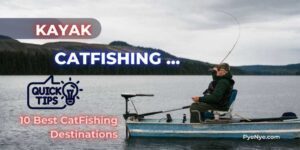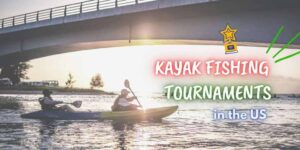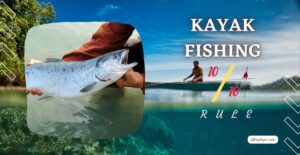As the warm summer months approach, many anglers turn their attention to crappie fishing. Although this popular game fish can be found year-round, summer presents unique opportunities and challenges for kayakers looking to catch crappie.
When the temperature rises, crappie moves to deeper and cooler waters, making it harder to locate and catch them.
For kayakers, this challenge can be even greater – navigating a small vessel through changing water conditions can require some finesse and strategic thinking.
However, with the proper techniques and gear, kayakers can increase their chances of success and reel in a bountiful catch.
To help you maximize your summer crappie fishing success, we’ve compiled a list of the ultimate summer crappie fishing hacks for kayakers. From adjusting your fishing techniques based on weather and water conditions to select the best gear and equipment, these tips and tricks will help you catch more crappie while enjoying the beauty and tranquillity of kayaking.
We will also discuss the importance of sustainable and ethical fishing practices and summarize laws and regulations surrounding summer crappie fishing.
Whether you’re a seasoned angler or a beginner, this guide will help you maximize your chances of catching crappie and ensure that you are fishing in an environmentally responsible and ethical manner.
Let’s start with why go for crappies in summer;
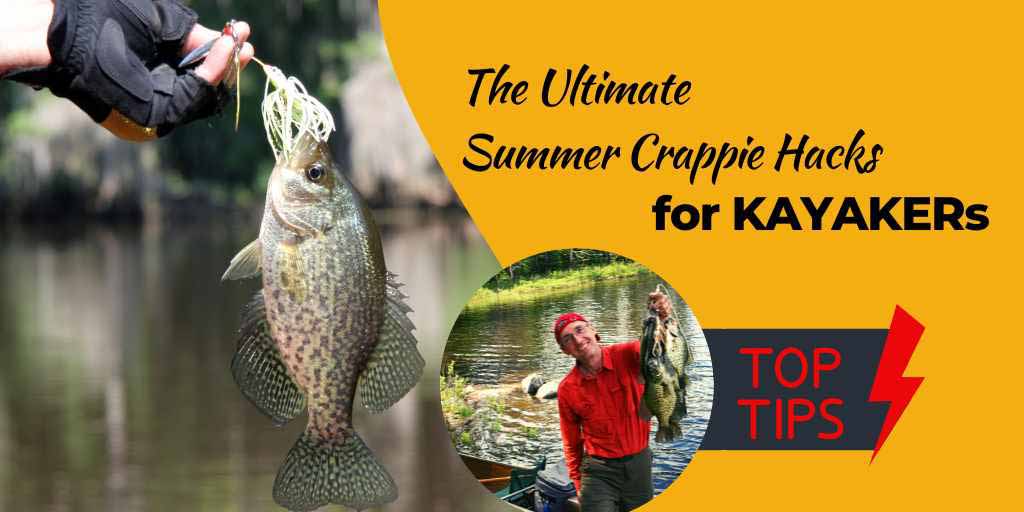
Jump To A Section
Why Go Fishing For Crappie In Summer?
If you’re an angler looking for a fun and rewarding fishing experience, consider targeting crappie during the summer months. Why? Well, there are several reasons summer is a great time to go crappie fishing.
For one thing, crappie tends to be more active in warmer water temperatures, so they are more likely to be biting during the summer. This can make for a more exciting and productive fishing trip, as you’ll have a greater chance of hooking into some nice-sized crappie.
Another reason to go crappie fishing in summer is that these fish move into shallower waters during this time of year. This can make them more accessible to anglers who are fishing from the shore or who are using smaller boats like kayaks or canoes. And because crappie is a popular game fish, it’s always satisfying to reel in a few big ones from waters that might have seemed too shallow or too murky at first glance.
Besides the increased activity levels and accessibility, summer is simply a great time to be out on the water. Whether you’re fishing with friends or family or just enjoying some solo time with nature, there’s something special about being out on a sunny day with a light breeze blowing and the sound of the water lapping against your boat.
And let’s remember the culinary aspect of crappie fishing in summer! These fish have a delicate and flavorful taste during this time of year, as they’ve had time to feed and grow during the spring and early summer. So if you’re looking for a tasty and healthy meal, then summer crappie might be what you’re after!
All in all, there are plenty of reasons to go fishing for crappie in summer. Whether you’re a seasoned angler or just looking for a fun outdoor activity, there’s nothing quite like the thrill of hooking into a few big crappies on a warm summer day.
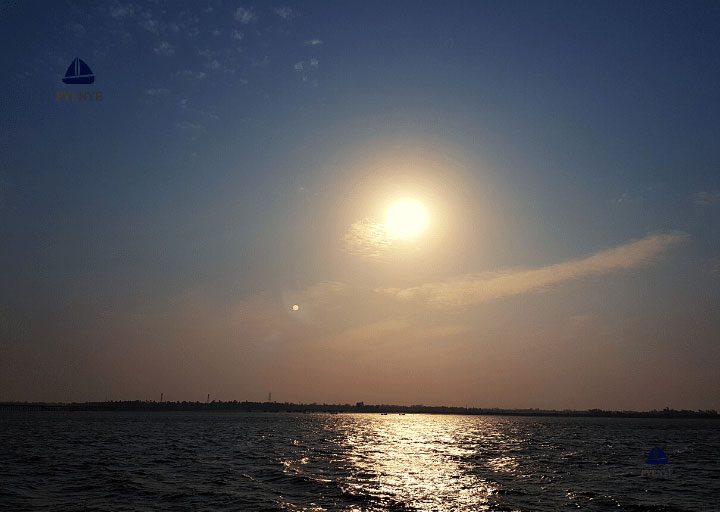
Understanding Summertime Crappie Behaviors For Fishing
Crappies are one of the most popular game fish in North America. And understanding their behavior during the summer months can help anglers improve their chances of success.
During this time of year, crappie can exhibit different behaviors than they do in the spring or fall, and we can find them in different parts of the water column. Typically, crappie moves to shallower waters during the summer to feed and spawn, but there are other factors that can affect their behavior as well.
Factors that affect crappie behavior in summer
Crappies are known for their delicious taste and exciting fight. However, catching crappie in the summer months can be a challenge, as their behavior and preferred habitats can change with the warmer weather.
Here are a few factors that affect their behavior in summer:
Water temperature
As water temperatures rise, crappie becomes more active and move to shallower waters. According to research, crappie is most active when water temperatures are between 65-75°F (18-24°C) (source).
Light conditions
Crappies are more active during low-light conditions, such as early morning, late evening, or cloudy days. When the sun is high in the sky, crappie may move deeper in the water column or seek cover to avoid the bright light.
Food availability
During the summer, crappie feeds heavily on small baitfish and insects that are abundant in shallow waters. Understanding the types of food that crappie are feeding on can help anglers choose the right lures and baits.
Water clarity
Crappies prefer waters with moderate clarity, as too much or too little clarity can make it more difficult for them to find food or avoid predators. Research has shown that crappie is most active when water clarity is between 2-5 feet (source).
Learn To Find Crappies In Summer
During the summer months, anglers can find crappie hotspots in various locations. When choosing a summer crappie fishing location, anglers should consider several factors, such as water temperature, structure, and depth. Specifically, water temperature is crucial because crappie tend to move to deeper, cooler waters during the hottest months of the year.
To identify crappie hotspots, anglers should look for areas with the right structure, such as fallen trees, brush piles, and submerged stumps. These areas provide cover and hiding spots for crappie to escape from predators.
Since crappie schools are together, it is effective to target areas with a high concentration of crappie.
Anglers should also experiment with different areas and techniques to see where crappie are biting. By using a combination of live bait and artificial lures, anglers can determine what the crappie are feeding on and what is most likely to attract them.
Being flexible and willing to adjust fishing location and technique based on changing conditions, such as water temperature or wind direction, can also lead to successful catches.
Some popular crappie hotspots across the US include Lake Guntersville in Alabama, Lake Fork in Texas, and Reelfoot Lake in Tennessee. However, it is important to note that crappie behavior and preferred habitats can vary by region and even within the same body of water.
Therefore, anglers should experiment and be open to adjusting their approach to increase their chances of a successful catch.
Tips and Tricks for catching more crappies in summer
Crappie fishing in the summer can be both exciting and challenging, as the fish tend to move to deeper waters and can be more difficult to locate. However, with a few summertime crappie fishing hacks, kayak anglers can increase their chances of success.
| Factors | Details |
| Water temperature | Crappies tend to move to deeper, cooler waters during the hottest months of the year. |
| Structure | Fallen trees, brush piles, and submerged stumps are great structures for crappie to hide from predators. |
| Depth | Crappies tend to school together in deeper waters during summer. |
| Bait/Lure | Using a combination of live bait and artificial lures can help determine what crappie are feeding on and what attracts them. |
| Time of day | Early morning and late afternoon/evening are the best times to catch crappie during summer. |
| Weather conditions | Overcast days with light rain are ideal conditions for crappie fishing. |
| Moon phase | The best time to catch crappie is during the new moon and full moon phases. |
| Location | Popular crappie hotspots across the US include Lake Guntersville in Alabama, Lake Fork in Texas, and Reelfoot Lake in Tennessee. |
What does crappie do in the summer?
In the summer, crappie tends to move to deeper, cooler waters and seek out areas with a structure such as fallen trees, weed beds, and submerged stumps for cover and protection from predators. They also tend to school together, making it important to target areas where there is a concentration of crappie.
How deep should you fish for crappie in the summer?
In the summer, crappie tends to move to deeper, cooler waters. Anglers should start by fishing in depths between 10-20 feet and adjust their depth based on water temperature and fish behavior.
What colors do crappie like in the summer?
In the summer, crappie can be attracted to a variety of colors depending on the water clarity and light conditions. Bright colors like chartreuse, pink, and white can be effective in murky water.
In clear water or bright sunlight, more natural colors like shad, bluegill, or silver can be effective. It’s also important to match the color of your lure or bait to the color of the local forage the crappie is feeding on in that particular body of water. Ultimately, it’s best to experiment with different colors and see what works best in your specific fishing location.
In clear water or bright sunlight, more natural colors like shad, bluegill, or silver can be effective. It’s also important to match the color of your lure or bait to the color of the local forage that the crappie is feeding on in that particular body of water. Ultimately, it’s best to experiment with different colors and see what works best in your specific fishing location.
What temperature do crappie bites best?
Crappies typically bite best when the water temperature is between 55 and 65 degrees Fahrenheit. However, this can vary depending on the time of day, weather conditions, and the specific body of water being fished. During the summer months, crappie may move to deeper, cooler waters, so finding the right temperature range may require some experimentation and adjustment in fishing location and technique.
To increase your catch rate in summer crappie fishing, it is important to pay attention to the details. This may include using a smaller hook, as crappie have smaller mouths and may be more likely to take a smaller bait. Additionally, changing up your bait or lure frequently can help attract more crappie to your line. Finally, it can be helpful to move your kayak around in different areas to cover more ground and locate schools of crappie.
Here are a few tips and tricks to maximize your catch, especially during summer;
Adjust fishing techniques based on weather and water conditions
One of the key tricks for adjusting fishing techniques in crappie hotspots is to pay attention to the weather and water conditions. During the hottest parts of the day, crappie tends to move to deeper, cooler waters. As such, fishing at different depths can be effective. Additionally, using lighter tackle can help make your lure or bait more enticing to crappie in hot weather conditions.
Tricks for handling and releasing crappie safely
When it comes to handling and releasing crappie safely, it is important to use a pair of pliers to remove the hook and handle the fish as little as possible. If you plan to release the fish, avoid holding it vertically or squeezing it too tightly, as this can damage the fish’s internal organs. Instead, hold the fish gently and horizontally, and release it quickly back into the water.
Necessary equipment for crappie fishing
To have a successful and enjoyable crappie fishing trip, it is important to have the right gear and equipment. This may include a kayak or small boat, fishing rods and reels, a variety of lures and baits, a fish finder or sonar, and a pair of pliers for removing hooks.
Additionally, having a life jacket, sunscreen, and a hat can help keep you safe and comfortable while out on the water.
Find the best crappie hotspots in your area
When it comes to finding the best crappie hotspots in your area, there are a number of tips and tricks that can help you increase your chances of success. One of the most effective methods for locating crappie is to use a fish finder or sonar. These devices can help you locate underwater structures, as well as schools of baitfish that are often a sign of crappie activity.
Another strategy is to look for areas with visible cover, such as fallen trees, weed beds, or docks. Crappies are known to seek shelter in these areas, so targeting them can be a great way to increase your chances of catching them. Pay attention to the water depth and structure, as these can also play a role in crappie behaviour during the summer months.
Observing other anglers
Observing other anglers or talking to local bait shops and fishing guides can also be a valuable source of information. These individuals often have firsthand knowledge of productive areas and can provide tips on where to find crappie in your area. You can also join local fishing groups or forums to connect with other anglers and gain insight into successful fishing techniques.
Be flexible with different lures
Finally, it is important to be flexible and willing to experiment with different lures and techniques in different areas to see where crappie are biting. Crappies can be finicky and may prefer one type of lure or technique over another, so it pays to be adaptable and try different approaches until you find what works best.
Conservation and Ethics in Summer Crappie Fishing
Conservation and ethics are essential aspects of fishing, especially in today’s world, where the fishing population is increasing rapidly. As an angler, it is your responsibility to follow sustainable fishing practices. Besides, you should also ensure that the fish populations you target remain viable for future generations. Sustainable fishing practices include proper handling and release techniques, following size and bag limits, and using non-destructive gear.
In addition to sustainable fishing practices, ethical considerations should also be taken into account when fishing for crappie in the summer. This includes treating the fish with respect, minimizing harm, and ensuring that the fish are released back into the water unharmed.
Some advice on ethical summer crappie fishing includes:
- Using barbless hooks to minimize harm to the fish
- Handling the fish gently and using a wet hand or cloth to prevent removing their protective slime layer
- Releasing the fish as soon as possible, avoiding prolonged air exposure
- Following size and bag limits set by local regulations
- Avoiding overfishing in popular areas to prevent the depletion of the fish population
Besides, It is important to be aware of the local laws and regulations surrounding summer crappie fishing.
These regulations vary by state and may include size and bag limits, seasonal restrictions, and gear restrictions. However, anglers should familiarize themselves with these regulations to avoid fines and penalties and to ensure sustainable and ethical fishing practices.
In conclusion, summertime crappie fishing can be a challenging yet rewarding experience for kayak anglers. By adjusting your fishing techniques based on weather and water conditions, using live bait, paying attention to details, and having the right gear and equipment, you can increase your chances of success and have a great time on the water.
